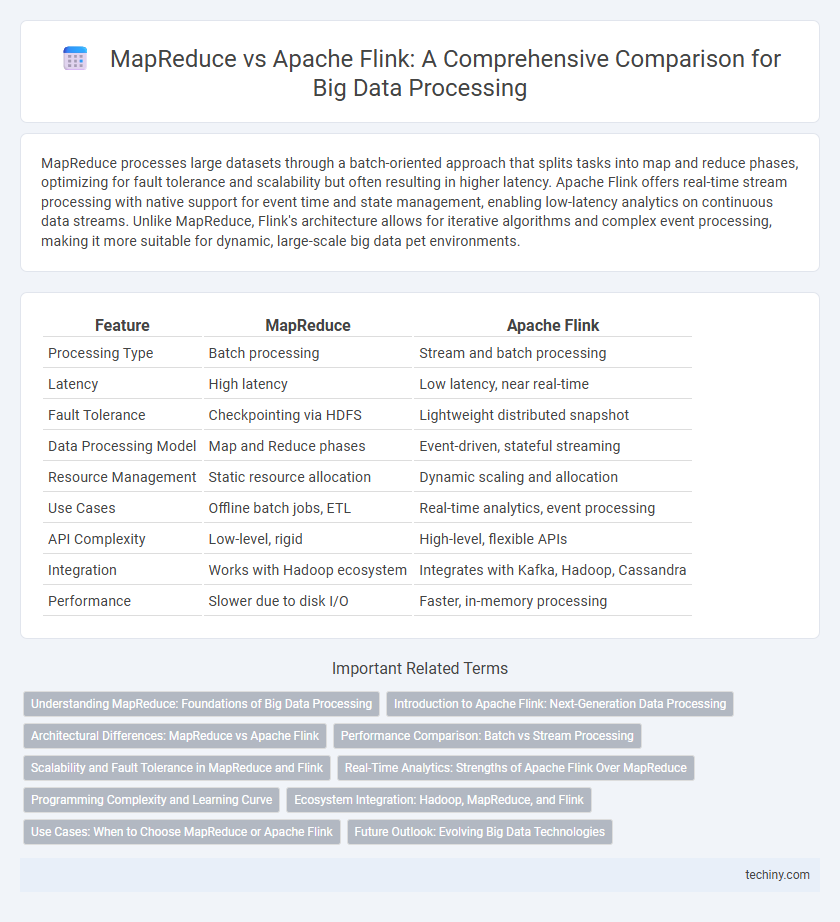MapReduce processes large datasets through a batch-oriented approach that splits tasks into map and reduce phases, optimizing for fault tolerance and scalability but often resulting in higher latency. Apache Flink offers real-time stream processing with native support for event time and state management, enabling low-latency analytics on continuous data streams. Unlike MapReduce, Flink's architecture allows for iterative algorithms and complex event processing, making it more suitable for dynamic, large-scale big data pet environments.
Table of Comparison
| Feature | MapReduce | Apache Flink |
|---|---|---|
| Processing Type | Batch processing | Stream and batch processing |
| Latency | High latency | Low latency, near real-time |
| Fault Tolerance | Checkpointing via HDFS | Lightweight distributed snapshot |
| Data Processing Model | Map and Reduce phases | Event-driven, stateful streaming |
| Resource Management | Static resource allocation | Dynamic scaling and allocation |
| Use Cases | Offline batch jobs, ETL | Real-time analytics, event processing |
| API Complexity | Low-level, rigid | High-level, flexible APIs |
| Integration | Works with Hadoop ecosystem | Integrates with Kafka, Hadoop, Cassandra |
| Performance | Slower due to disk I/O | Faster, in-memory processing |
Understanding MapReduce: Foundations of Big Data Processing
MapReduce, developed by Google, revolutionized big data processing by introducing a simplified programming model based on the map and reduce functions, enabling distributed computation across large datasets. Its foundation lies in dividing tasks into smaller sub-tasks processed in parallel on commodity hardware, ensuring scalability and fault tolerance. While MapReduce excels in batch processing, it struggles with real-time analytics, a challenge addressed by newer frameworks like Apache Flink.
Introduction to Apache Flink: Next-Generation Data Processing
Apache Flink is a next-generation data processing framework designed for scalable, high-throughput, and low-latency stream and batch processing. Unlike MapReduce, which relies on disk-based batch processing, Flink offers in-memory computation and native stream processing capabilities, enabling real-time analytics and stateful computations. Its advanced event-time processing and fault tolerance mechanisms make it a preferred choice for complex, continuous data pipelines in Big Data ecosystems.
Architectural Differences: MapReduce vs Apache Flink
MapReduce employs a batch processing architecture that divides tasks into map and reduce phases, relying on disk-based storage between stages which can introduce latency. Apache Flink uses a stream processing architecture with in-memory computation and pipelined execution, enabling low-latency, real-time data processing. Flink's architecture supports stateful computations and event-time processing, providing more flexibility and efficiency compared to the rigid batch-oriented design of MapReduce.
Performance Comparison: Batch vs Stream Processing
MapReduce excels in batch processing by efficiently handling large-scale data with high throughput but suffers from high latency, making it less suitable for real-time analytics. Apache Flink offers superior performance for stream processing with low latency and true stateful computations, enabling real-time data processing at scale. Flink's ability to seamlessly switch between batch and stream processing provides a versatile solution with faster data processing and more complex event handling compared to the traditional MapReduce framework.
Scalability and Fault Tolerance in MapReduce and Flink
MapReduce offers strong fault tolerance through its task re-execution mechanism, ensuring data processing reliability despite node failures, but its scalability is often limited by the batch-oriented nature and high latency of its disk-based data shuffle. Apache Flink excels in scalability with its native support for stream processing, enabling low-latency, stateful computations across distributed clusters that dynamically adjust to workload demands. Flink's checkpointing and state management mechanisms provide robust fault tolerance, allowing fast recovery and minimal data loss in real-time processing scenarios.
Real-Time Analytics: Strengths of Apache Flink Over MapReduce
Apache Flink excels in real-time analytics by processing data streams with low latency and high throughput, unlike MapReduce which relies on batch processing and incurs higher lag. Flink's native support for event-time processing and complex event processing enables precise, real-time insights critical for time-sensitive applications. Its fault-tolerance and state management capabilities further enhance consistent, reliable stream processing that MapReduce's batch model cannot match.
Programming Complexity and Learning Curve
MapReduce employs a simplistic programming model based on key-value pairs, which can lead to verbose code and complex job chaining for advanced workflows, increasing programming complexity. Apache Flink offers a more expressive API supporting event-driven and iterative processing, reducing code verbosity and enabling faster development cycles. While MapReduce has a steeper learning curve due to manual job orchestration, Flink provides higher-level abstractions that ease pipeline construction and streamline the learning process for big data developers.
Ecosystem Integration: Hadoop, MapReduce, and Flink
MapReduce is tightly integrated within the Hadoop ecosystem, leveraging HDFS for storage and YARN for resource management, enabling batch processing of large datasets. Apache Flink offers native connectors to Hadoop components like HDFS and YARN, while also supporting real-time stream processing alongside batch workloads. Flink's versatility allows seamless integration with Hadoop's ecosystem tools, providing enhanced performance and low-latency processing compared to traditional MapReduce jobs.
Use Cases: When to Choose MapReduce or Apache Flink
MapReduce excels in batch processing tasks requiring high fault tolerance and simplicity, making it ideal for large-scale data aggregation and ETL jobs. Apache Flink is preferred for real-time stream processing, complex event-driven applications, and low-latency analytics due to its ability to handle data in motion with stateful computations. Organizations should choose MapReduce for stable, offline batch workflows and opt for Flink when continuous event processing and immediate insights are critical.
Future Outlook: Evolving Big Data Technologies
MapReduce, a foundational big data processing model, faces limitations in real-time analytics and complex event processing compared to Apache Flink's advanced stream processing capabilities. Apache Flink's future outlook is promising due to its low-latency, high-throughput architecture designed for dynamic, iterative algorithms and large-scale data streams. As big data technologies evolve, Flink's ability to unify batch and stream processing positions it as a preferred framework for next-generation data-intensive applications.
MapReduce vs Apache Flink Infographic

 techiny.com
techiny.com